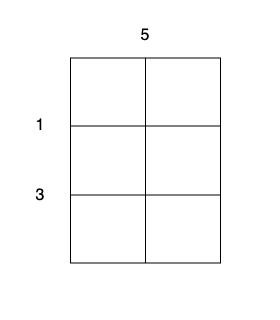3218. Minimum Cost for Cutting Cake I
Description
There is an m x n cake that needs to be cut into 1 x 1 pieces.
You are given integers m, n, and two arrays:
horizontalCutof sizem - 1, wherehorizontalCut[i]represents the cost to cut along the horizontal linei.verticalCutof sizen - 1, whereverticalCut[j]represents the cost to cut along the vertical linej.
In one operation, you can choose any piece of cake that is not yet a 1 x 1 square and perform one of the following cuts:
- Cut along a horizontal line
iat a cost ofhorizontalCut[i]. - Cut along a vertical line
jat a cost ofverticalCut[j].
After the cut, the piece of cake is divided into two distinct pieces.
The cost of a cut depends only on the initial cost of the line and does not change.
Return the minimum total cost to cut the entire cake into 1 x 1 pieces.
Example 1:
Input: m = 3, n = 2, horizontalCut = [1,3], verticalCut = [5]
Output: 13
Explanation:
- Perform a cut on the vertical line 0 with cost 5, current total cost is 5.
- Perform a cut on the horizontal line 0 on
3 x 1subgrid with cost 1. - Perform a cut on the horizontal line 0 on
3 x 1subgrid with cost 1. - Perform a cut on the horizontal line 1 on
2 x 1subgrid with cost 3. - Perform a cut on the horizontal line 1 on
2 x 1subgrid with cost 3.
The total cost is 5 + 1 + 1 + 3 + 3 = 13.
Example 2:
Input: m = 2, n = 2, horizontalCut = [7], verticalCut = [4]
Output: 15
Explanation:
- Perform a cut on the horizontal line 0 with cost 7.
- Perform a cut on the vertical line 0 on
1 x 2subgrid with cost 4. - Perform a cut on the vertical line 0 on
1 x 2subgrid with cost 4.
The total cost is 7 + 4 + 4 = 15.
Constraints:
1 <= m, n <= 20horizontalCut.length == m - 1verticalCut.length == n - 11 <= horizontalCut[i], verticalCut[i] <= 103
Solutions
Solution 1: Greedy + Two Pointers
For a given position, the earlier you cut, the fewer cuts are needed, so it is clear that positions with higher costs should be cut earlier.
Therefore, we can sort the arrays \(\textit{horizontalCut}\) and \(\textit{verticalCut}\) in descending order, and then use two pointers \(i\) and \(j\) to point to the costs in \(\textit{horizontalCut}\) and \(\textit{verticalCut}\), respectively. Each time, we choose the position with the larger cost to cut, while updating the corresponding number of rows and columns.
Each time a horizontal cut is made, if the number of columns before the cut was \(v\), then the cost of this cut is \(\textit{horizontalCut}[i] \times v\), and then the number of rows \(h\) is incremented by one; similarly, each time a vertical cut is made, if the number of rows before the cut was \(h\), then the cost of this cut is \(\textit{verticalCut}[j] \times h\), and then the number of columns \(v\) is incremented by one.
Finally, when both \(i\) and \(j\) reach the end, return the total cost.
The time complexity is \(O(m \times \log m + n \times \log n)\), and the space complexity is \(O(\log m + \log n)\). Here, \(m\) and \(n\) are the lengths of \(\textit{horizontalCut}\) and \(\textit{verticalCut}\), respectively.
1 2 3 4 5 6 7 8 9 10 11 12 13 14 15 16 | |
1 2 3 4 5 6 7 8 9 10 11 12 13 14 15 16 17 18 19 | |
1 2 3 4 5 6 7 8 9 10 11 12 13 14 15 16 17 18 19 20 | |
1 2 3 4 5 6 7 8 9 10 11 12 13 14 15 16 17 18 | |
1 2 3 4 5 6 7 8 9 10 11 12 13 14 15 16 17 18 19 | |



